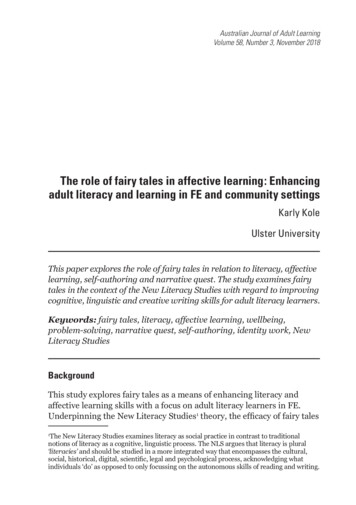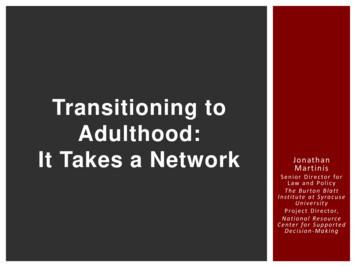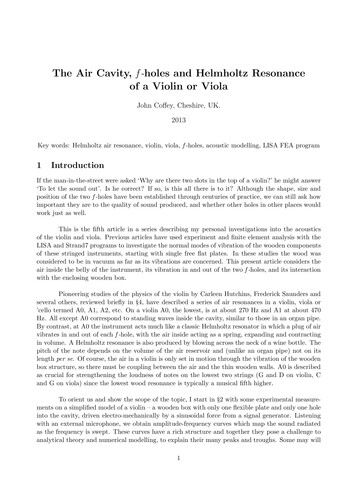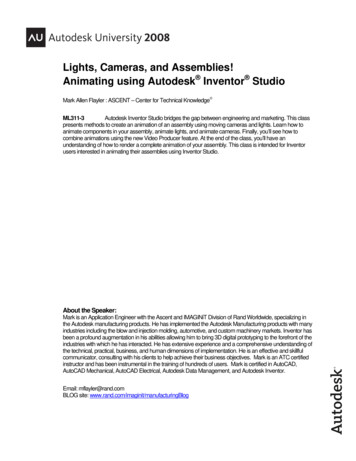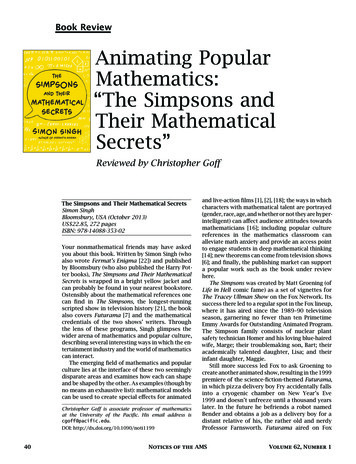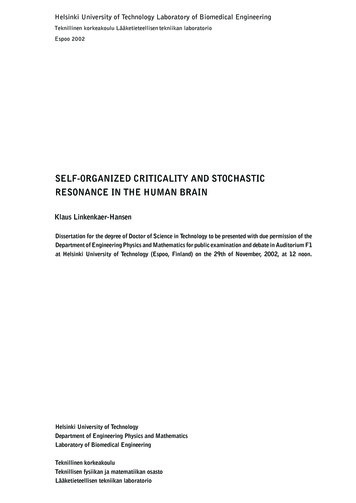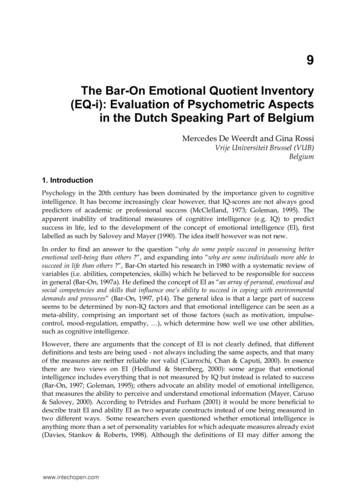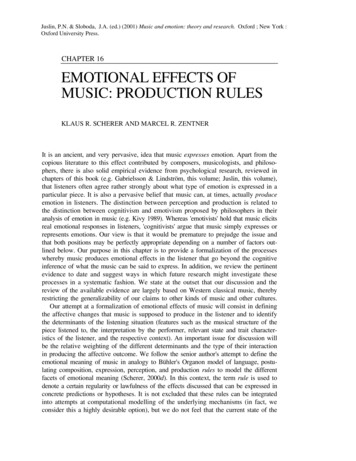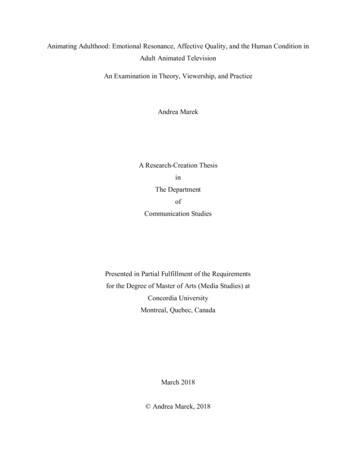
Transcription
Animating Adulthood: Emotional Resonance, Affective Quality, and the Human Condition inAdult Animated TelevisionAn Examination in Theory, Viewership, and PracticeAndrea MarekA Research-Creation ThesisinThe DepartmentofCommunication StudiesPresented in Partial Fulfillment of the Requirementsfor the Degree of Master of Arts (Media Studies) atConcordia UniversityMontreal, Quebec, CanadaMarch 2018 Andrea Marek, 2018
iiCONCORDIA UNIVERSITYSchool of Graduate StudiesThis is to certify that the thesis preparedBy:Entitled:Andrea MarekAnimating Adulthood: Emotional Resonance, Affective Quality, and the . Human Condition in Adult Animated TelevisionAn Examination in Theory, Viewership, and Practiceand submitted in partial fulfillment of the requirements for the degree ofMaster of Arts (Media Studies)complies with the regulations of the University and meets the accepted standards with respect tooriginality and quality.Signed by the final Examining Committee:ChairDr. Owen ChapmanExaminerDr. Mia ConsalvoExaminerProfessor Richard HancoxSupervisorProfessor Timothy SchwabApproved byChair of Department or Graduate Program DirectorDean of FacultyDate
iiiABSTRACTAnimating Adulthood: Emotional Resonance, Affective Quality, and the Human Condition inAdult Animated TelevisionAn Examination in Theory, Viewership and PracticeAndrea MarekAt its core, adult animation is animated content specifically created for an adult audience.Adult animation represents the intersection of childhood with its colorful package, and the oftencrippling reality of adulthood, with its content. What may initially appear as sweet and benignentertainment is in actuality an environment for self-reflexivity, where individuals are confrontedwith their own personal issues, and the reality of adulthood through the struggles of thecharacters and the narratives explored, both good and bad. The programming offers an escapefrom one’s own problems, while engaging with the characters provides a surrogate experience.This recent shift in adult animated television is emotionally driven, ranging in theme fromsimply making it through the everyday, to having an existential crisis. Programs discussedinclude BoJack Horseman, Rick and Morty, F is for Family, and animals. This paper reflects amulti-perspective approach to research, which is particularly lacking in animation studies, andwhere there is often a stringent divide between theory and practice. Accordingly the threesections of this paper correspond to three approaches to adult animation: theoretical, content orviewer based, and production or maker based, which includes a discussion of the accompanyingcreation component.
ivAcknowledgementsThank you to my supervisor Tim Schwab for your unwavering positivity throughout thisentire process. There was not even the slightest hesitation on your part when I explained that Iwanted to do another film that would involve puppets.Thank you to Mia Consalvo and Rick Hancox for their roles as my committee members.Thank you to Doug Hollingworth and Mike Smart for their mentorship on all the technical andproduction-related aspects of this research.Thank you to my parents Dorota and Jan Marek, for your support throughout this entireprocess. Thank you for letting me turn our house into my personal fabrication studio whichincreasingly took over more and more rooms. To my grandfather Stefan Wiercinski, youcontinue to inspire me to go out every day and seek adventure.This research project is dedicated to my mother, Dorota Marek for teaching me to see thelife, the story, and the endless possibilities in the everyday objects around me. This work trulywould not have been possible without you. Through the late-night fabrication, and with yourendless supply of pep talks, you were the beacon of encouragement that kept me going.Five years, and two degrees later, thank you to the Department of CommunicationStudies for providing me the opportunity to learn and grow as a person in such an incredibleenvironment with such amazing faculty, staff, and peers.
vTable of ContentsList of Images.viIntroduction: Animation and Adult Animation – Terms, and Historical Overview.1Part 1: Theoretical Framework and Research.4Theoretical Framework: An Introduction – Theory vs. Practice / Theory and Practice.4Much More than Movement: Situating Animation.5Life and Death.6Age and Escapism.8Technology and Storytelling.10Part 2: Media Texts and Viewing.12Forming the Television Viewing Relationship.12Sample Group: BoJack Horseman, F is For Family, Rick and Morty, animals.13The Adult Animated Hero: The Damaged / Anti-Hero.17Animated Reality: The Animated Human Condition.18Labor and Work: The Animated Everyday Reality.19Action: The Animated Existential Crisis.20Comedy and Intertextuality: Understanding the Adult Animation Genre.24Part 3 – Research Creation and Making.25Situating the Work.25Logistics, Process, and Perfomativity.26Thematic Exploration.28The Subject as Real: Agency and Technology.29Reconciling Roles: Creator-Viewer-Researcher.31Conclusion: Connecting the Dots and Lines.33Bibliography.36Mediography.41Appendix: Sample Production Images.44
viList of ImagesFigure 1: BoJack Horseman characters: Mr. Peanutbutter, Diane, and BoJack.14Figure 2: BoJack Horseman characters: Princess Carolyn and Todd.14Figure 3: F is For Family characters: Bill, Kevin, Sue, Maureen, and Frank.15Figure 4: Rick and Morty characters: Jerry, Beth, Summer, Morty, and Rick.16Figure 4: animals. sample characters: rats.17
1Introduction: Animation and Adult Animation – Terms and HistoricalOverviewAnimation is a chameleon; at times a technique, a genre, or style, animation is both the practiceand the end result. Animation is many things at once. If a conventional film is one that is mappedout shot-by-shot, the animated film takes this one step further, mapping out the narrative frameby-frame whether this is done with drawings, on a computer, with cutouts, or with puppets.Animation can be described as any media material which uses an animation technique, regardlessof the narrative content, but this explanation is endless, encompassing all techniques, all mediaof any genre using animation techniques such as animated comedy, animated documentary,animated horror, and animated science fiction. “[A]nimation is an imprecise, fuzzy catchall thatheaps an enormous and historically far-reaching, artistically diverse body of work into one pot”(Buchan, “Animation, in Theory” 113). A great deal of effort is made by scholars who writeabout animation to achieve a conclusive definition, but the results remain inconclusive. There isno all-encompassing framework in which to examine animation simply because of its scope anddiversity. Consequently, in order to avoid generalization across all animation, this paper isfocused on an examination of a particular subsection of animation, adult animation, solely withinthe context of television.Adult animation (occasionally referred to as mature animation) in its simplest terms canbe described as animated content intended for adults. What is key here is marking the differencebetween adult animation, and elements of adult content sprinkled throughout family orchildren’s-oriented animation. Additionally the use of the term animation rather than cartoon isused because of its inclusivity of all types of animation regardless of the particular techniquebeing used such as traditional drawn animation, stop-motion, or digital animation, etc.Fundamentally what sets adult animation apart from animation in general is its intended adultaudience. Consequently it is the differences in narrative content of the adult animated genrewhich provides a stronger point of distinction from animation in general than the visuals. As withdefining the term animation, the exact terminology associated with adult animation isinconsistent. It is at times recognized as a sub-genre of animation, and at other timesdistinguished as a standalone genre. Adult animation is not solely focused on adults fascinatedby the fantastical nature of the visual that the genre uses, but rather the ever expansive genre ofadult animation as a progressive means of storytelling. At its core adult animation combines the
2innocence of childhood in form, with the reality of adulthood and the human condition, incontent.Historically, adult animated television has evolved from conventional family-orientedtelevision animation and the integration of elements of adult humor in order to appeal to thewhole family (Mittell 67). Animated television on the whole has wavered in popularity, that is,until the clear division of content, which normalized children’s animated content as weekendmorning programming, and family content as prime-time content taking place during eveninghours (Mittell 66-68). The conjunction of primetime and animated content is what initiated andultimately solidified the relationship between adults and animated content. With its originalsurge in popularity in the 1950’s and 60’s, primetime animation fell out of fashion andexperienced a significant dry period with the final episode of The Flintstones airing in primetimein 1966, until December 1990 when The Simpsons premiered1 (Mittell 71). The three programswhich popularized the genre both for audiences and academics alike are The Simpsons (1990present), Family Guy (1999-present) and South Park (1997-present). These three programs areoften seen as archetypes for adult animation, not only due to their longstanding success but alsobecause they contain many of the presumptions that have become associated with adultanimation: misogynistic content intended for a young male (often white) audience, reliance oncrude humor including sex, bathroom humor, violence and alcohol as central elements—highlighting certain tropes those unfamiliar with the genre might expect. However, these initialiterations of the genre have also been progressive, featuring family-driven and dysfunctionalfamily storylines, social and political commentary, and subsequently laying the groundwork foremotionally-driven storylines. This was followed by a plethora of early 2000 iterations2 such asKing of the Hill (1997-2009), Futurama (1999-2003, 2008-2013), Aqua Teen Hunger Force(2000-2015), The Boondocks (2005-2014), Squidbillies (2005-present), Robot Chicken (2005present), American Dad (2005-Present), Archer (2009-Present), all of which expanded genericconventions and increased popularity but still relied on elements of the existing generic tropes.Increasingly as adult animation gained traction, the programs evolved, expanding the types ofissues that the characters faced, integrating serious elements—a sort of testing of audienceresponse—while still under the veil of comedy in order to not entirely scare off audiences.12The Simpsons has since gone on to be the longest running primetime comedy (Mittell 71)See David Perlmutter’s America Toons in: A History of Television Animation for a more complete list.
3A recent shift now situates adult animated television no longer simply as a means ofentertainment, or even social criticism, but rather has evolved into a space for catharsis related toserious emotional issues and trauma through the exploration of topics that greatly stray from theassumption of animation as either a child’s innocent colorful medium, or a crude boy’s club.Adult animated television still relies heavily on comedic elements as well as the sitcom format inconjunction with these new dramatic elements, resulting in a redefinition of many shows withinthe genre being described with a plethora of names such as dramedy (drama comedy)3, darkcomedy4, and sadcom (sad comedy) 5 (Bramesco, Jaffe). The overarching point being theconvergence of comedy with drama or more serious, even ‘sad’ content. Animation is not onlyexperiencing a resurgen
experienced a significant dry period with the final episode of The Flintstones airing in primetime in 1966, until December 1990 when The Simpsons premiered1 (Mittell 71). The three programs which popularized the genre both for audiences and academics alike are The Simpsons (1990-present), Family Guy (1999-present) and South Park (1997-present).
